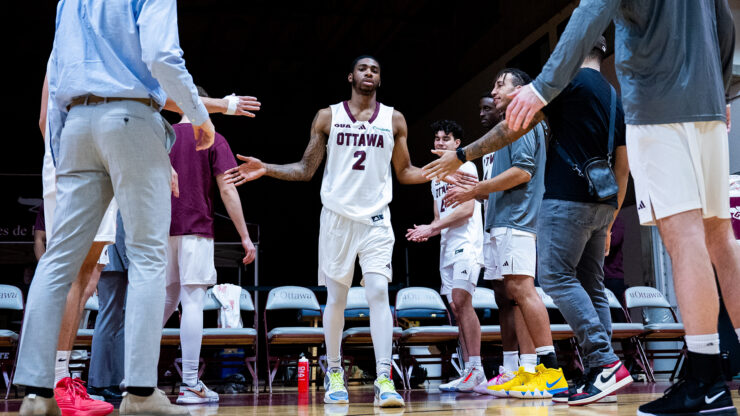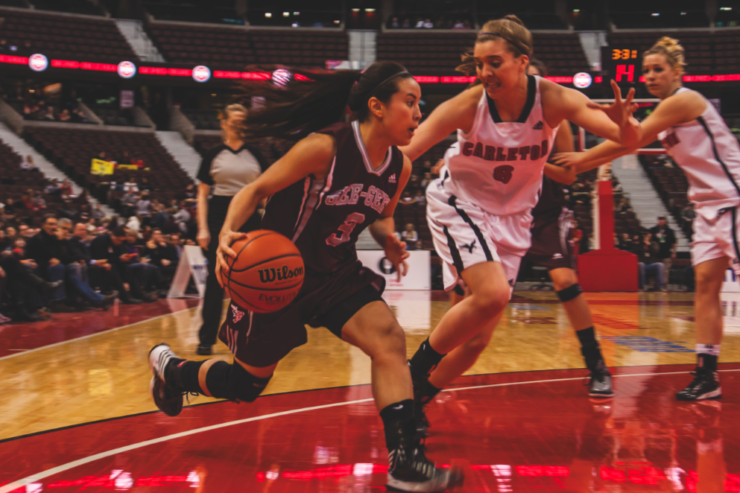How the homophobic culture of university sport is slowly changing
Darren Sharp | Fulcrum Staff
Illustration by Mathias MacPhee
NOTE: This feature was originally published online on Oct. 17, 2012. It was later published in the print edition on Nov. 29, 2012.
AS I’M WAITING for my interview with a closeted bisexual football player to begin, I consider how awkward this conversation will probably be. I don’t know anything about John*, really. I know that he played football for a Canadian university team, I know that he’s bisexual, and I know that he’s told just a select few about his same-sex attraction. Only through a couple twists of fate did I find out about him and convince him to agree to an interview. Closeted people, in my experience, are very guarded and evasive when it comes to discussing their sexuality. I expect the next half hour to be like pulling teeth.
Around 1:30 pm, John strolls into the building. At first glance, he’s your typical jock⎯a brick house of a man, gym bag hanging off one shoulder. There are people littered around, but no one knows what he’s here to discuss. I usher him into my office and shut the door for maximum privacy. As we sit down and exchange hellos, I notice that the timid, sheepish guy I expected to be talking to is nowhere to be found. Instead, John has a million dollar smile plastered on his face and an eagerness to get the interview started.
“I’m very comfortable with my personality and my sexuality,” he would tell me later. “No subject is taboo to me.”
Sport, I discovered, is full of these social contradictions.
The nature of competitive team sports is that one learns not to be a team player, but to be complicit to the authority of an individual who is normally given far too much power.
The final frontier
Most gay men can pinpoint exactly when they began to realize they were attracted to other men. Even though his bisexuality was a recent revelation, John’s memory is a bit foggy.
“I don’t even know how it started,” he says. “One day I kind of wanted to try sex with the same sex.”
John’s laid back attitude toward his sexuality baffles me, especially given his position as an athlete. I expected to hear tortured stories about not being able to sleep at night because he was so consumed by fear and shame; instead, my interviewee acts as though it’s the least important thing on his mind.
“I’m new at this too, but slowly I’m telling more people,” he says. “I think that at some point I’ll have to tell everybody. It’s not like a, ‘Hey, I’m bi!’ It’s more like, ‘Yeah, I’m bi. Sure, let’s talk about it.’”
His comfort level begs the question: If it’s such a non-issue, why isn’t he completely out of the closet? He has his reasons⎯very legitimate reasons, which he’s asked me not to share⎯but very few of them have to do with being a football player.
Unfortunately, not all athletes are able to feel as comfortable as John does. Until just over a month a go, Jamie Kuntz was a bruising linebacker at the North Dakota State College of Science. Over Labor Day weekend, Jamie was caught kissing his boyfriend in the press box at one of his team’s games. He was swiftly removed from the squad after the incident. School officials maintain that Jamie’s dismissal had nothing to do with his sexuality⎯he was supposed to be filming the game, which he failed to do, and afterward he lied about the events that occurred⎯but Jamie is convinced they’re not telling the whole truth.
“In my opinion, I think my sexuality had 100% to do with the school’s decision,” he said in an email to the Fulcrum.
Unlike John, Jamie’s story is what you might expect to hear from a once-closeted gay athlete. He can recount times where he was made to feel very uncomfortable on the field.
“My decision [to not come out earlier] was made because of multiple actions by the coaches and players,” he said. “I would hear gay jokes everywhere I turned. One of the players that I got along best with there told me, ‘My uncle is gay and I don’t like him for it.’ One of the coaches would take time out of practice to make fun of a player for how he stood with his hands on his hips, and talk in a girly voice mimicking his name.”
With North American society sprinting toward equality for the LGBT community, sports culture has moved at more of a crawl. Locker rooms are one of the last places where homophobia occurs largely unchallenged. This is nothing new; sport is almost always one of the final dams to break when equality is rushing through the rest of society. One need only to look at how long it took for sports to move past the race barrier to see that it’s often the final frontier for social change.
Eric Anderson is a professor from the University of Winchester in the UK who’s done extensive research on homosexuality in university sport. He believes that sport adjusts so slowly because all of the power is concentrated in one place.
“Sport is what I call a ‘near-total institution,’” he told the Fulcrum in an email. “A total institution, like a prison or the military, is one that controls every move one makes, all day long.
“Sport is similar. In order to excel up the rapidly decreasing opportunity structure, you must not only be a good athlete, but your mentality must conform to the orders of the lead⎯the coach. If you don’t meet (usually his) expectations, then you don’t get selected for the next round. Thus, the nature of competitive team sports is that one learns not to be a team player, but to be complicit to the authority of an individual who is normally given far too much power.”
The problem is that homosexuality doesn’t fit into the small box that the sport institution tries to slot each athlete into. The pressure to conform to what an athlete is supposed to be⎯strong, fearless, masculine⎯remains very present.
It’s been labeled that you require a certain level of masculinity to be able to be an athlete, and then as an athlete you’re awarded the social perception of masculinity, as well. So it kind of feeds into its own system.
The masculine ideal
When I ask John about athletes he looks up to, he lights up like a Christmas tree.
“My role model was Jack Lambert,” he says, smile at full wattage. “Jack Lambert was probably the meanest motherfucker out there. He had four teeth in his mouth, a big moustache, a snarl the whole day on his face. This guy was just mean! He would hit everybody. He was the tough guy.”
Like many athletes, John clearly values certain traits that are emphasized by sport culture: Power. Toughness. Masculinity.
“I have to be fast, I have to be strong,” he says. “It makes your job a lot easier if the guy is scared shitless of you. For most people, there is a big pressure to be that alpha male. Everybody wants to be number one. And number one is the strongest guy, number one is the toughest guy.”
In 2011, Anderson published a study called Updating the Outcome: Gay Athletes, Straight Teams, and Coming Out in Educationally Based Sport Teams, wherein he interviewed gay university and high school athletes about their experiences.
“Sports associate boys and men with masculine dominance by constructing their identities and sculpting their bodies to align with hegemonic perspectives of masculinist embodiment and expression,” he wrote in the article. “Boys in competitive team sports are therefore constructed to exhibit, value, and reproduce traditional notions of masculinity.”
Bryan Fautley, a former volleyball player at Queen’s University who struggled with reconciling his homosexuality with his sport, knows the pressure to fit into the stereotypical “manly” mold all too well.
“I definitely agree that sport is a hyper-masculine institution,” he said. “It’s been labeled that you require a certain level of masculinity to be able to be an athlete, and then as an athlete you’re awarded the social perception of masculinity, as well. So it kind of feeds into its own system.”
Bryan knew he was gay from the age of 16, but as a talented, competitive athlete, he was hesitant to come out to his teammates at Queen’s. This made real friendships with them nearly impossible.
“My relationship with the volleyball team beforehand was I’d go to practice like it was a job,” he said. “I wouldn’t really speak to anybody, had no desire to hang out with the guys after practice. On the weekends, I’d avoid them at all costs. We didn’t have any type of friendship beyond practice or games.”
In his third year, a miserable Bryan came out to his coach, who had noticed that something was wrong. However, even with his coach behind him, the pressure became so intolerable that at the end of the season⎯after a year of helping propel Queen’s to a national championship appearance⎯he quit the team altogether.
Bryan’s coach, concerned, asked if she could tell the team the truth about why he was leaving.
“I said, ‘You can do whatever you want, because I don’t plan on talking to them ever again,’” he recalled.
However, Bryan was blown away by what happened once his team discovered the real reasons he was cutting his athletic career short.
“Every single guy was not only apologetic for what they did to put me in the position that they did, but the conversation was not necessarily along those lines,” he said. “The conversation was more focused on how happy they were for me that I could feel comfortable enough at this point in my life that they got to find out.”
His relationship with the team repaired, Bryan returned to play for Queen’s over his final years at the school. Unknowingly, he had paved the way for other athletes who don’t fit perfectly into the stereotypical masculine mold.
“We had a rookie on the team in my fourth year that was gay,” he said. “He had a great relationship with the guys. It was very open. He’s not someone that would ever shy away from his sexuality. He was really great to have on the team because he brought a totally different dynamic and perspective to a lot of guys on the team because he wasn’t the most traditional athlete in terms of the hyper-masculine and the aggressive attitude. He was definitely more of a feminine guy, and the guys had a lot of fun with it.”
In the conclusion of Updating the Outcome, Anderson notes the changing attitudes of athletes toward homosexuality and masculinity, indicating that the positive experience Bryan witnessed with the gay rookie may be becoming the norm.
“At least for the men in this study,” Anderson states, “homophobia seems to be losing its utility as a tool for the establishment of masculine acceptability among peers.”
“We’re not asking you to turn locker rooms into this kumbaya, love everybody place,” he said. “We’re just trying of get people to take out that little bit of language.”
Other “colourful” words
If the indestructible masculine ideal that sport perpetuates is slowly being chipped away, then what of homophobic speech on the field? When I bring up locker room talk to John, he gives a fairly typical locker room answer.
“We call each other everything that goes through our heads,” he says. “We’ll call each other ‘homos’ just like we’ll call each other ‘jerk-offs’ and ‘assholes’ and whatever. I think that we give each other vulgar nicknames more than we actually say our names. It’s such a different atmosphere.”
Calling someone a “fag” during a game is often thought of as an inevitability⎯just boys being boys.
“It’s never going to go away,” says John. “It’s a part of the culture. If I’d come out, I don’t think it would change any of the comments.”
Scott Heggart⎯a University of Ottawa student and former high school hockey goalie⎯is trying to change that attitude. Scott works with You Can Play, an organization that “is dedicated to ensuring equality, respect and safety for all athletes, without regard to sexual orientation,” according to their website.
“The locker room is not a very friendly place,” said Scott. “That’s one of the great things about You Can Play. Me and Patrick [Burke, co-founder of You Can Play] were just recently talking to the Toronto Marlies training camp. One of the things that Patrick said was, ‘There’s a lot of [other] colourful words you can call people.’”
When Scott came out in high school, his team’s reaction was extremely positive.
“I got a bunch of text messages and messages on Facebook from both current and old teammates,” he said. “Basically, the overwhelming message was, ‘Scott, I’m proud of you, it took a lot of courage, it doesn’t change anything.’”
Having witnessed first-hand the denigrating comments that get thrown around the rink, Scott has a unique perspective with which to share the You Can Play message.
“We’re not asking you to turn locker rooms into this kumbaya, love everybody place,” he said. “We’re just trying to get people to take out that little bit of language. Some of [my teammates] that were going on these rants about how much of a ‘homo’ the ref was, these were the people who sent me messages on Facebook about how they admired my courage and they supported me.”
He believes that athletes often don’t think about how their words can affect those around them.
“A lot of the time it’s a disconnect. Does that justify what the people are saying? No,” he said. “Because at the same time, expressing homophobia, whether or not it’s subconscious, is still very, very damaging to people who are in the closet and for people who may not understand that it’s just subconscious.”
The only conclusion
As our surprisingly forthcoming interview starts winding down, I ask John if he has any advice for a gay high school athlete who is considering whether or not they want to continue playing their sport in university. He pauses thoughtfully before responding.
“There’s going to be a lot of pressure coming up,” he says calmly. “Find a way to make peace with it, and maybe tell somebody or deal with it in some kind of way to relieve some of the pressure that you’re going to put on top of a bigger pressure. There’s going to be a pressure in school, pressure in friends, pressure in [sports], pressure in having a life, for fuck’s sake.
“I would [come out] when you’re comfortable⎯it might take a month, it might take three years⎯but definitely find a way to do it. I think it’d be better.”
When the interview ends, we shake hands, and John walks out as confidently as he walked in. After the door closes, I stay sitting down, stunned. How has a strapping, ferocious football player who is also bisexual been able to reconcile those two aspects of himself amid the immense pressure that sport places on him to be a certain type of man?
The only conclusion I could come to⎯and it’s a conclusion that John, Eric Anderson, Bryan Fautley, and Scott Heggart have echoed⎯is that the homophobic culture of sport⎯especially university sport⎯is changing. Like all social movements in the athletic world, the change is slow and delayed. But it’s happening. And that’s something we should all be cheering for.
*Name changed to protect anonymity.






